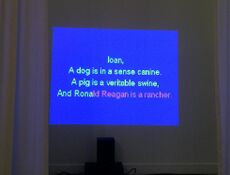Karaoke Bar
| Karaoke Bar | |
|---|---|
 | |
| The Red Crayola with Art & Language | |
| Project | |
| Year | 2005 |
| Dimensions | |
| Materials | |
Background
- Discussed in
 Letters to the Red Crayola XII
Letters to the Red Crayola XII

Track list
Incomplete list
- Portrait of V. I. Lenin in the Style of Jackson Pollock, Part I
- Marches No's 23, 24, 25
- An Old Man's Dream
- Hedges
Exhibitions
Incomplete list
| Date | Location | ||
|---|---|---|---|
| May 11 - June 2, 2005 | Lisson Gallery, London | [3] |
Retrospectives
Art & Language, Letters to the Red Crayola XII, 2012
As it turned out, the karaoke worked best in a small and rather informal looking room that easily became crowded. There was far more attack and brio from the singers who were standing close, not only to friends, but also to people who were nodding acquaintances at best. The effect of the larger room with the cool furniture, posters and contemporary reading matter was, as we did not predict, less conducive to singers — except rather competent and self-assured ones, including Gina Birch who sang along, following her own recorded voice. What can we tell from this? Possibly that the people who sang in Nantes were not British and therefore not quite as tight-assed as the more reluctant performers in London. I don't think that's a strong reason, as the French are not at all keen on looking foolish — and a karaoke performance is ipso facto foolish. Could it be that in the small space, where singers rubbed shoulders with others, there was a sense of mutual complicity, that the neighbours of the singers whose bodies made contact were somehow joining in? Well, perhaps the quantification of joiners-in is not the point. A certain embarrassment, a joining-in at the tip of the tongue, hut not quite achieved, is in some ways culturally superior to a jolly sing-along. But it's hardly news to say there's deflation in frustration. The karaoke text has something of the 'Index' works about it. It comes in strips and in colours and it is annotated by its own theoretical progress as (sung) lyric — as something finally to be produced by the voice. The index works might have been produced as a sort of karaoke conversation, annotated so as to be quasi-operatic. In fact, the quite often implausible lyrics of 'Corrected Slogans' are as much attached to the indexes as they are to our later and more sober reflections. (And there has to be some connection between the lyrics themselves and the levels of embarrassment and alienation available: 'That's when your heartaches begin' vs. 'Jackson Pollock was the artist of the Marshall Plan', vs. 'Hey there, you with the stars in your eyes'.) You could also say that the music of 'Corrected Slogans' crackles with some of the madness of the index-ing talk. It includes — or factors in — the dogs whose barking joins the conversation.
Reviews
Frieze
October 13, 2005[4]
Andrew Hunt
[...] The karaoke event took place between 5pm and 6pm each day, and tracks from the album Kangaroo? (1981), such as ‘A Portrait of V. I. Lenin in the Style of Jackson Pollock’ were available to sing along to. Another ‘gross and conspicuous error’ started to operate here, but this time the question appeared to be, what kind of historical displacement occurs when we the spectators, as blind performers, sing these 24-year-old lyrics? As before, we are complicit in our own bad performance and misreading of these essay-like texts and through a historical distance provide a necessary misinterpretation of Art & Language’s work. This is an essential component of the group’s practice, and if they represent a resistance to the category of Conceptual art, where a Duchampian model is ‘emptied of its transgressive potential and rendered congenial to the managers of interdisciplinarity’, then maybe this combination of music and politics is something to strive for. If the original intention of these irreconcilable forces was to ‘stress the grammar and the sense of the text to the point of oblivion’, then through the lens of history this partnership at least still appears alien and strange, but for different reasons. When current bands are mimicking the urgency of outfits from the late 1970s, minus the political awareness, and younger artists and curators are fixated on radical models but lacking any real substance, there’s another, unwitting form of historical karaoke operating. Perhaps what we need right now are more deliberately irresponsible yet ‘real’ collaborations of this sort.